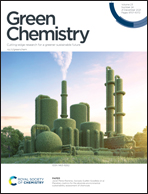Visible-light-driven prompt and quantitative production of lactic acid from biomass sugars over a N-TiO2 photothermal catalyst†
Abstract
Chemocatalytic production of lactic acid from biomass feedstock is an alternative route with high potential, but with the prerequisites of long reaction time, high temperature, and/or a tailored catalyst. In this work, an N-TiO2 photothermal catalyst prepared by a simple sol–gel method using urea as a nitrogen and carbon source could catalyse a variety of biomass sugars to quantitatively produce lactic acid (up to 98.9% yield) in water under visible light and at a low temperature of 60 °C in a time as short as 30 min. N-TiO2 provides a suitable valence band position (2.51 eV) for the photo-oxidation reaction, with more active species being formed on the catalyst surface (e.g., h+, e−, ˙OH and ˙O2) and a light-induced heating effect caused by the carbon photothermal layer, which can effectively activate carbohydrates to undergo a cascade reaction process. Theoretical calculations show that the charge of N-TiO2 is highly separated, in which the N element acts as an electron trap and is enriched with plenty of electrons, leading to effective isolation of holes and electrons. In addition, the N-TiO2 catalyst exhibits good reusability and can be recycled with little loss of activity. The developed N and C-enhanced photothermal synergistic protocol opens up an avenue for producing organic acids from renewable biomass resources under mild conditions.



 Please wait while we load your content...
Please wait while we load your content...